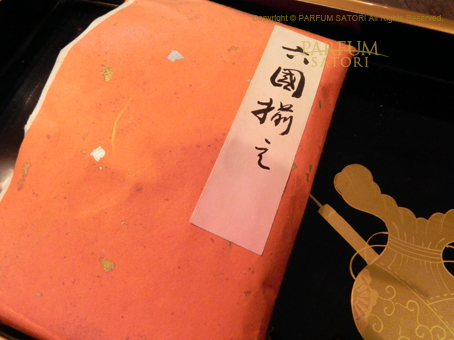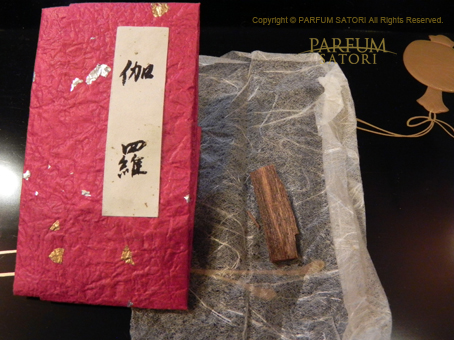
[Rikkoku-Gomi] (meaning 6 countries and 5tastes)is the grading of "Jinko"(Japanese Incense Wood)
As mentioned earlier, the wood used in Kodo is called "Jinko (Agarwood)" .
A tiny piece of Jinko is warmed on the incense burner and we "listen" to its fragrance.
In Kodo we use the term "listening" instead of "smelling".
We listen to the fragrance until it gives us an answer".
The red wrapping on the picture above contains 6 different "Koh (incense fragrance)"packets.
Each one of the packets contains a little piece of wood, all with a similar woody fragrance.
Perfumes have a wide variation. Just like a painting corner of an art supplies store, where we can find a wide range of colors in gradation from red, yellow, and blue.
However, different fragrances of wood are not like perfumes. It is more like the different variations of the color brown.
We have to be very sensitive in order to distinct the slightest differences.
These different wood fragrances are classified into 6 categories, so called "Rokkoku (meaning 6 countries)".
Originally the woods were classified by the regions they came from.
While the grading name "Rokkoku" remained, the classification is now done by quality.
The grading has 5 characteristics (or 5 tastes) such as sweet, spicy, sour, bitter, and salty.
These are called "Gomi (meaning 5 tastes)".
Kodo has 2 Schools with different styles, "Shinoryu (derived from Samurai family)" and "Sanjonishi-Oieryu (derived from Aristocrat family)".
The grading differs depending on the school.
In the 17th century, people tried to literally define the types of fragrances, but it ended up being harder because we have to remember the fragrances without being influenced by the wordy definitions.
Below are the names and fragrance explanations of the 6 different grades.

KYARA
"Its gentleness and bitterness is elegant. Graceful as an aristocrat."
The smoke rises beautifully and last for a long time, so does its fragrance, which lasts all the way through, from the first guest until the last guest has finished.
The fragrance has a volume and stretches out.
We say its taste "include all 5 tastes". "Ranjantan" (a national treasure) is known to possess the 5 tastes.
It can look very dark and sticky, some with layers. May be originally from Vietnam.

MANABAN
"Sweet but gradually fades with time and become rough, like a coarse peasant."
The name comes from the Malabar Coast of southern India.

RAKOKU
"Bitter as a Samurai"
"Rakoku" means Tailand.

"Its light fragrance is delicate and difficult to distinct, just like the fickle one of changing moods."
It is also known as having "no taste".
The name comes from Malacca between Indonesia and Malaya, which is also the place where Magellan died in battle while sailing around the world on his westward route.
(Kyara, Rakoku, Manaban, Manaka are Agallocha or Malaccensis belonging to the Aquilaria family.)

SASORA
"A cool and sour fragrance. Good ones smell like Kyara at the beginning but light at the end, just like a monk."
The name may have come from a place called Sasora in the western shores of India.
It is sometimes described as "spicy" or "salty".
(In the botanical category, this jinko belongs to the Pterocarpus family. Different from the 4 types above.)

SUMOTARA
"The Servant disguised as a noble."
Sumotara is difficult to distinct. The very beginning smell is good but does not seem to last.
The smell is perplex and may depend on the seating order.
The name comes from the island of Sumatra.
(In the botanical category, this jinko belongs to the Gonislylus family. Different from the others.)